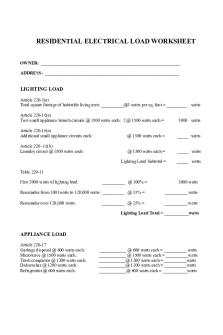LOAD CELL - Working principle of Load Cell strain guage PDF

| Title | LOAD CELL - Working principle of Load Cell strain guage |
|---|---|
| Author | Ibtisam Rashed |
| Course | Aerospace Instrumentation |
| Institution | Institute of Space Technology |
| Pages | 3 |
| File Size | 206.1 KB |
| File Type | |
| Total Downloads | 27 |
| Total Views | 150 |
Summary
Working principle of Load Cell strain guage...
Description
LOAD CELL
1. Objective: •
To understand the working principle of Strain gauge Load Cell
•
To understand the basics of sensor implementation by the use of Arduino Uno.
•
To learn the basic coding required for implementing any sensor by use of Arduino coder.
2. Introduction: A load cell is a type of force gauge. It consists of a transducer that is used to create an electrical signal whose magnitude is directly proportional to the force being measured. The various load cell types include hydraulic, pneumatic, and strain gauge. For our project we have used Strain gauge Load Cell which is basically a resistance based load cell.
Fig. 1 Load Cell 10 kg
1. Working Principle: Strain gauge load cells are the most common in industry. These load cells are particularly stiff, have very good resonance values, and tend to have long life cycles in application. Strain gauge load cells work on the principle that the strain gauge (a planar resistor) deforms when the material of the load cells deforms appropriately. Deformation of the strain gauge changes its electrical resistance, by an amount that is proportional to the strain. The change in resistance of the strain gauge provides an electrical value change that is calibrated to the load placed on the load cell.
Fig. 2 Schematic diagram of Load cell working
A load cell usually consists of four strain gauges in a Wheatstone bridge configuration. The electrical signal output is typically in the order of a few millivolts (mV) and requires amplification by an instrumentation amplifier before it can be used for the purpose of amplification we will use HX711 Load Cell Amplifier. The output of the transducer can be scaled to calculate the force applied to the transducer. Sometimes a high resolution ADC, typically 24-bit, can be used directly.
Fig. 3 Wheatstone bridge circuit of strain guage sensor The gauges themselves are bonded onto a beam or structural member that deforms when weight is applied. In most cases, four strain gauges are used to obtain maximum sensitivity and temperature compensation. Two of the gauges are usually in tension can be represented as T1 and T2, and two in compression can be represented as C1 and C2, and are wired with compensation adjustments. The strain gauge load cell is fundamentally a spring optimized for strain measurement. Gauges are mounted in areas that exhibit strain in compression or tension. When weight is applied to the load cell, gauges C1 and C2 compress decreasing their resistances. Simultaneously, gauges T1 and T2 are stretched increasing their resistances. The change in resistances causes more current to flow through C1 and C2 and less current to flow through T1 and T2. Thus a potential difference is felt between the outputs or signal leads of the load cell. The gauges are mounted in a differential bridge to enhance measurement accuracy. When weight is applied, the strain changes the electrical resistance of the gauges in proportion to the load....
Similar Free PDFs

D5731 Point Load Strength
- 7 Pages

DESIGN AGAINST FATIGUE LOAD
- 20 Pages

LOAD FLOW ANALYSIS
- 9 Pages

LOAD FLOW STUDIES
- 42 Pages

Earthquake Load Combinations
- 4 Pages

Práctica Load - xxx
- 1 Pages

DIGITAL LOAD CONTROLLER (DLC)
- 8 Pages

TGN-1-4 Derivation of wind load
- 5 Pages

Cell mitosis - cell mitotsis
- 4 Pages

CIVE1151 Lect 3 eqivalent load
- 17 Pages

Text 1 - Cognitive Load Theory
- 2 Pages

Adeptal Energy vs Load Analysis
- 14 Pages

20 Total Load Part 2
- 2 Pages

Structure of generalized cell
- 2 Pages
Popular Institutions
- Tinajero National High School - Annex
- Politeknik Caltex Riau
- Yokohama City University
- SGT University
- University of Al-Qadisiyah
- Divine Word College of Vigan
- Techniek College Rotterdam
- Universidade de Santiago
- Universiti Teknologi MARA Cawangan Johor Kampus Pasir Gudang
- Poltekkes Kemenkes Yogyakarta
- Baguio City National High School
- Colegio san marcos
- preparatoria uno
- Centro de Bachillerato Tecnológico Industrial y de Servicios No. 107
- Dalian Maritime University
- Quang Trung Secondary School
- Colegio Tecnológico en Informática
- Corporación Regional de Educación Superior
- Grupo CEDVA
- Dar Al Uloom University
- Centro de Estudios Preuniversitarios de la Universidad Nacional de Ingeniería
- 上智大学
- Aakash International School, Nuna Majara
- San Felipe Neri Catholic School
- Kang Chiao International School - New Taipei City
- Misamis Occidental National High School
- Institución Educativa Escuela Normal Juan Ladrilleros
- Kolehiyo ng Pantukan
- Batanes State College
- Instituto Continental
- Sekolah Menengah Kejuruan Kesehatan Kaltara (Tarakan)
- Colegio de La Inmaculada Concepcion - Cebu

